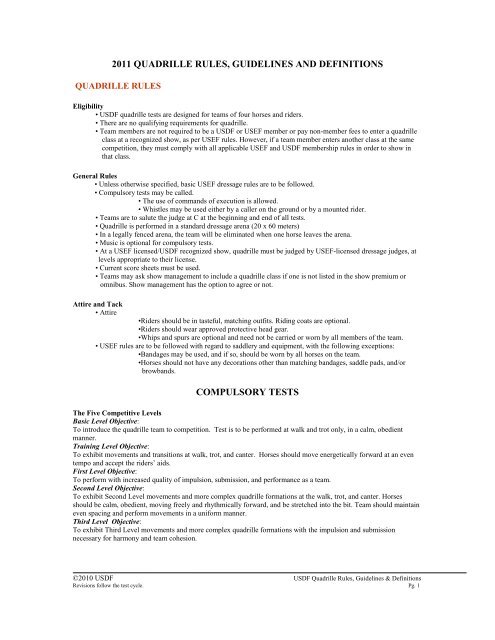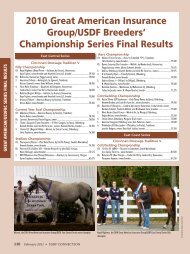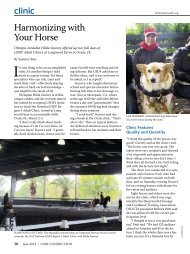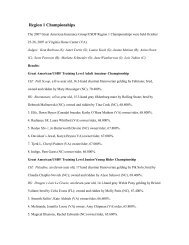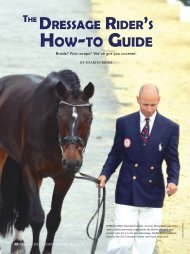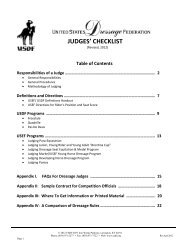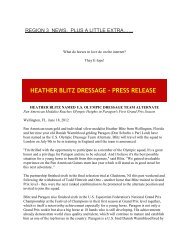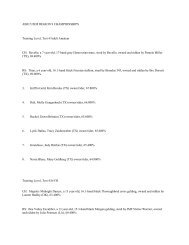Quadrille Rules
Quadrille Rules
Quadrille Rules
You also want an ePaper? Increase the reach of your titles
YUMPU automatically turns print PDFs into web optimized ePapers that Google loves.
2011 QUADRILLE RULES, GUIDELINES AND DEFINITIONS<br />
QUADRILLE RULES<br />
Eligibility<br />
• USDF quadrille tests are designed for teams of four horses and riders.<br />
• There are no qualifying requirements for quadrille.<br />
• Team members are not required to be a USDF or USEF member or pay non-member fees to enter a quadrille<br />
class at a recognized show, as per USEF rules. However, if a team member enters another class at the same<br />
competition, they must comply with all applicable USEF and USDF membership rules in order to show in<br />
that class.<br />
General <strong>Rules</strong><br />
• Unless otherwise specified, basic USEF dressage rules are to be followed.<br />
• Compulsory tests may be called.<br />
• The use of commands of execution is allowed.<br />
• Whistles may be used either by a caller on the ground or by a mounted rider.<br />
• Teams are to salute the judge at C at the beginning and end of all tests.<br />
• <strong>Quadrille</strong> is performed in a standard dressage arena (20 x 60 meters)<br />
• In a legally fenced arena, the team will be eliminated when one horse leaves the arena.<br />
• Music is optional for compulsory tests.<br />
• At a USEF licensed/USDF recognized show, quadrille must be judged by USEF-licensed dressage judges, at<br />
levels appropriate to their license.<br />
• Current score sheets must be used.<br />
• Teams may ask show management to include a quadrille class if one is not listed in the show premium or<br />
omnibus. Show management has the option to agree or not.<br />
Attire and Tack<br />
• Attire<br />
•Riders should be in tasteful, matching outfits. Riding coats are optional.<br />
•Riders should wear approved protective head gear.<br />
•Whips and spurs are optional and need not be carried or worn by all members of the team.<br />
• USEF rules are to be followed with regard to saddlery and equipment, with the following exceptions:<br />
•Bandages may be used, and if so, should be worn by all horses on the team.<br />
•Horses should not have any decorations other than matching bandages, saddle pads, and/or<br />
browbands.<br />
COMPULSORY TESTS<br />
The Five Competitive Levels<br />
Basic Level Objective:<br />
To introduce the quadrille team to competition. Test is to be performed at walk and trot only, in a calm, obedient<br />
manner.<br />
Training Level Objective:<br />
To exhibit movements and transitions at walk, trot, and canter. Horses should move energetically forward at an even<br />
tempo and accept the riders’ aids.<br />
First Level Objective:<br />
To perform with increased quality of impulsion, submission, and performance as a team.<br />
Second Level Objective:<br />
To exhibit Second Level movements and more complex quadrille formations at the walk, trot, and canter. Horses<br />
should be calm, obedient, moving freely and rhythmically forward, and be stretched into the bit. Team should maintain<br />
even spacing and perform movements in a uniform manner.<br />
Third Level Objective:<br />
To exhibit Third Level movements and more complex quadrille formations with the impulsion and submission<br />
necessary for harmony and team cohesion.<br />
©2010 USDF USDF <strong>Quadrille</strong> <strong>Rules</strong>, Guidelines & Definitions<br />
Revisions follow the test cycle. Pg. 1
Judging<br />
• There is no set spacing that teams must use, and it can change from movement to movement. But whatever<br />
is chosen, the spacing must be maintained by all.<br />
• Riders may rise or sit the trot, but all should do the same in any given movement.<br />
• Use of trained quadrille judges is recommended. However, any dressage judge from the current USEF<br />
Roster of Licensed Officials may judge quadrille classes and judge at levels appropriate to their license.<br />
• Up to three (3) judges may be seated on the short end or one (1) may sit on the long side.<br />
Collective Marks<br />
• Spacing: Consistency in maintaining distance between horses, laterally and longitudinally.<br />
• Synchrony & Alignment: Uniformity and precision in changing direction or moving from one figure to<br />
another, as well as in the execution of all movements and figures.<br />
• Impulsion: Degree of energy adequate for the level.<br />
• Submission: Degree of acceptance of the riders’ aids, adequate for the level.<br />
• Performance as a Group: Ability to perform with uniform quality and in a harmonious, cooperative manner.<br />
QUADRILLE FREESTYLE RULES<br />
QUADRILLE FREESTYLE<br />
Eligibility<br />
• There are no qualifying requirements for quadrille.<br />
• Team members are not required to be a USDF or USEF member or pay non-member fees to enter a quadrille<br />
class at a recognized show, as per USEF rules. However, if a team member enters another class for which<br />
participant membership is required they must comply with all applicable USEF and USDF membership rules<br />
in order to show in that class.<br />
General <strong>Rules</strong><br />
<strong>Quadrille</strong> freestyle is an artistic program created by a team of four horses and riders. <strong>Quadrille</strong> freestyles are creative<br />
rides with music using dressage elements from the appropriate compulsory level. Creativity and artistic presentation, as<br />
well as technical precision, will be scored.<br />
• Freestyles are offered at all levels from Basic through Grand Prix. The level must be stated on the entry.<br />
• The <strong>Quadrille</strong> Freestyle is performed in a standard dressage arena (20 x 60 meters)<br />
• The team does not submit a copy of the program in advance.<br />
• Freestyles must be ridden from memory.<br />
• Whistles may be blown, as for compulsory tests.<br />
• Current USDF quadrille freestyle score sheets must be used.<br />
Time<br />
• Freestyle time limits:<br />
• There is no minimum time.<br />
• Basic - five minutes maximum<br />
• Training through Intermediate - six minutes maximum<br />
• Grand Prix – seven minutes maximum<br />
• The first rider must enter the arena or signal the sound engineer within 45 seconds of the entry bell, or the<br />
team will be eliminated.<br />
• The horses must enter the arena in single file. Once inside the arena, the team may use a configuration of its<br />
choice to come to a halt facing the judge. This configuration may not exceed 30 seconds from the time the last<br />
horse enters the arena up to the halt itself.<br />
• The program is timed and judged from the move-off of the lead horse or pair, after the initial halt and salute.<br />
Timing and judging will cease at the final salute.<br />
• The bell or whistle is not sounded at the time limit.<br />
• Anything performed after the time limit has elapsed will not be scored. One (1) point will be<br />
deducted from the total points for exceeding the time limit by more than 10 seconds.<br />
©2010 USDF USDF <strong>Quadrille</strong> <strong>Rules</strong>, Guidelines & Definitions<br />
Revisions follow the test cycle. Pg. 2
Music<br />
• Music is mandatory. Exit music is not allowed.<br />
• If the music source fails, the team may (time permitting and at the discretion of management):<br />
•Restart immediately, or<br />
•Be rescheduled to perform the freestyle in its entirety at some later time during the<br />
competition.<br />
• Competitors must pick up their music before leaving the show. If the competitor does not pick up their music<br />
show management has the option to discard the material.<br />
Judges<br />
• Two sets of marks are given: one for technical execution (collective marks) and one for artistic impression.<br />
Each set of marks is totaled separately, then added together and converted to the final percentage.<br />
• In case of a tie, the higher score for artistic impression will break the tie.<br />
• If there are two (2) judges or more, they all judge both the technical execution and the artistic impression.<br />
• Up to three (3) judges may be seated on the short end or one (1) may sit on the long side.<br />
• Technical Execution Marks may be given in half or full points. Artistic Impression Marks may be given in<br />
tenth (.1) points.<br />
Equipment and Turnout<br />
• Saddlery and tack are the same as for compulsory tests.<br />
• Riders’ outfits may reflect the musical theme but should be conservative and should match, as distinct from a<br />
costume class. Horses should not have any decorations other than matching bandages, saddlepads, and/or<br />
browbands.<br />
• Special costume classes may be offered, in which case the horses may also be “decorated.”<br />
ELEMENTS OF QUADRILLE FREESTYLE<br />
• Compulsory Elements: All of the required elements for the level that are listed on the score sheet, whether movement,<br />
figure, pace or transition.<br />
• Dressage Movements: An exercise as opposed to a figure, transition or a pattern. Dressage Movements are leg yields,<br />
rein-back, shoulder-in, travers, renvers, turn on haunches, half-pass (trot or canter), flying change, pirouette (walk or<br />
canter), piaffe, and passage.<br />
• Figures: Geometrical component of a dressage test such as circle, serpentine, and figure-of-eight.<br />
• Transitions: Changes between two different gaits or from one pace to another within the same gait.<br />
• Combinations: Direct connection of any movement or figure with another movement or figure.<br />
• Patterns: Geometric design formed in the arena when movements, figures and transitions are combined.<br />
(There is some overlap. As examples: a simple change is a compulsory element and a combination; a half-pass is a<br />
dressage movement, but half-pass zigzag in trot is a pattern, and half-pass zigzag in canter with flying change is a<br />
combination and a pattern.)<br />
Other quadrille definitions can be found in the quadrille section of the Glossary of Judging Terms in the Directory.<br />
REQUIREMENTS AND LIMITATIONS<br />
• All compulsory elements for the level must be incorporated into the program. They are listed under Technical<br />
Execution.<br />
• Performing a dressage movement found in a higher level test than the one being declared is strictly forbidden.<br />
• Any figures, pattern, combinations, or transitions composed of elements permitted in the declared level are<br />
permitted. There are no limitations on shape, or combination of figures, even if the resulting configuration is<br />
found in higher levels.<br />
• The following is a list of dressage elements specifically<br />
permitted and forbidden at each level.<br />
Basic Level (Walk/Trot only)<br />
Clearly Forbidden:<br />
Any lateral work, rein-back, canter, turn-on-haunches, piaffe, passage.<br />
Clearly Allowed:<br />
Anything not clearly forbidden.<br />
©2010 USDF USDF <strong>Quadrille</strong> <strong>Rules</strong>, Guidelines & Definitions<br />
Revisions follow the test cycle. Pg. 3
Training Level<br />
Clearly Forbidden:<br />
Any lateral work, counter-canter, simple change, flying changes, rein-back, turn-on-haunches or pirouette<br />
at walk, pirouette at canter, piaffe, passage.<br />
Clearly Allowed:<br />
Anything not clearly forbidden.<br />
First Level<br />
Clearly Forbidden:<br />
Rein-back, shoulder-in, travers, half-pass, flying changes, turn-on-haunches or pirouette at walk, pirouette<br />
at canter, piaffe.<br />
Clearly Allowed:<br />
Counter-canter (any configuration), leg-yield (any configuration), lengthen trot or canter on 20-meter<br />
circle, simple change, canter-halt, halt-canter.<br />
Second Level<br />
Clearly Forbidden:<br />
Half-pass, flying changes, pirouette at canter, piaffe, passage.<br />
Clearly Allowed:<br />
Full and double turn-on- haunches, renvers, travers, medium trot and canter on 20-meter circle, medium<br />
canter on diagonal.<br />
Third Level<br />
Clearly Forbidden:<br />
Tempi changes (4s, 3s, 2s, 1s), canter pirouette, piaffe, passage.<br />
Clearly Allowed:<br />
Everything that is not clearly forbidden, including: half-pass zigzag in trot, half-pass zigzag in canter with<br />
flying changes, full and double walk pirouettes.<br />
Fourth Level and FEI Levels<br />
Must state level. Follow USDF freestyle guidelines for what is clearly forbidden and clearly allowed (Third and Fourth<br />
Levels) and FEI Intermediate I and Grand Prix freestyle score sheets for what is forbidden/allowed.<br />
SCORING AND JUDGING<br />
Two (2) sets of marks are given—one for technical execution and one for artistic impression. Each set of marks is<br />
totaled separately, and then those totals are added together and converted to the final percentage score. In the case of<br />
two or more judges, scores will be averaged and these averages will comprise the competitor’s final score. The<br />
technical execution score mirrors that of the standard quadrille tests.<br />
UNDERSTANDING ARTISTIC IMPRESSION<br />
Choreography<br />
• Design<br />
The layout and construction of the pattern and combination of patterns.<br />
• Balance<br />
Use of space; the comprehensive use of the entire arena.<br />
• Direction<br />
Suitable balance between left and right.<br />
• Creativity (including degree of difficulty)<br />
The non-test-like nature and ingenuity of the patterns and combinations.<br />
• Difficulty<br />
Exceeding the requirement for the standard test of the same level.<br />
Musicality<br />
•Rhythm/tempo<br />
Appropriateness of rhythm and tempo to the gaits of the horses.<br />
• Cohesiveness<br />
Music selections are from one genre, style or theme.<br />
• Phrasing & dynamics<br />
Choreography reflects changes in the music.<br />
©2010 USDF USDF <strong>Quadrille</strong> <strong>Rules</strong>, Guidelines & Definitions<br />
Revisions follow the test cycle. Pg. 4
• Seamlessness<br />
Cuts and transitions are smooth and create an overall flow of the music.<br />
Harmony of Presentation, Fluency of performance<br />
• Absence of resistance/disobedience.<br />
Team Appearance<br />
• Matching attire and tack.<br />
Other definitions pertaining to quadrille can be found in the quadrille section of the USDF Glossary of Judging Terms.<br />
QUADRILLE FREESTYLE GUIDELINES<br />
Music<br />
• Any type of music may be selected.<br />
• It is strongly recommended that music for a quadrille freestyle ride be of one genre, style, or theme. Mixing<br />
musical genres within one program is not recommended. A cohesive musical theme will be scored higher than<br />
a disjointed arrangement of musical selections.<br />
• Strict tempo of music in relation to gaits is not required. However, for an effective quadrille freestyle, the<br />
tempo of the music should match the tempo of the horse’s gaits.<br />
• Music that can be interpreted choreographically and create highlights is encouraged.<br />
• Vocals are permitted<br />
• Entrance music is optional but advised, as it provides a sound check.<br />
• Editing should be fluid and smooth. Choppy or disruptive editing will detract from the overall Artistic<br />
Impression.<br />
•The format for the quadrille freestyle music should be a CD. Final preparation of the music in a professional<br />
studio is recommended to ensure proper equalization, balance, and decibel levels.<br />
• The CD should have only the quadrille freestyle ride on it. It should be clearly labeled with the team’s name<br />
and level of ride.<br />
• Always bring an extra copy of the music to the competition. Mark it in the same way as the original,<br />
plus some additional notation indicating that it is a backup copy. ALWAYS HAVE IT READILY<br />
AVAILABLE.<br />
• Consult the competition prize list for information about sound checks and to whom the CD should go.<br />
• Each team should be permitted one representative in the sound system booth to supervise the handling<br />
of the music. This person should not interfere with the show announcer or management in any way.<br />
• According to Section 115 of the Copyright Act, a mechanical license must be obtained for the re-recording of<br />
music in any format. For information on obtaining a mechanical license, it is recommended that the rider<br />
contact the National Music Publisher’s Association at www.nmpa.org.<br />
• Teams must pick up their music CDs before leaving the show. If the team does not pick up<br />
their music show management has the option to discard the material.<br />
Choreography<br />
• The team must enter in single file, however it may employ any pattern it chooses to come to the halt, and it<br />
may halt in any configuration it wishes.<br />
• The beginning and end of the quadrille (halt and salute) must be executed facing C.<br />
• Each competitive level has specific compulsory elements (listed on the score sheet) that must be performed.<br />
• The team can include mirror image, side-by-side, and in-line positioning.<br />
• The horses should be shown to best advantage, commensurate with the level of training, and maximizing their<br />
strengths.<br />
• Creativity and degree of difficulty in the composition are rewarded.<br />
• The choreography should utilize the entire arena as imaginatively as possible, with a suitable balance between<br />
left and right.<br />
• Movements, figures and their placement should be obvious to the judge.<br />
• The letters of the arena serve as markers only. Movements or figures need not be executed at the letters,<br />
however, the choreographic construction should be clear and logical.<br />
• Any element included in the freestyle program must be performed by all members of the team.<br />
• Most required elements must be shown on both hands (directions), however each member is not<br />
required to show it on both hands. This does NOT apply to GAITS. Trot and canter must be shown on both<br />
hands (Training Level and above). Walk is not required on both hands.<br />
• Inclusion of dressage movements above the comparable dressage level will incur a penalty of four points from<br />
“Total Technical Execution.” This deduction will be taken for each such forbidden movement, but not for<br />
each recurrence of the same forbidden movement.<br />
©2010 USDF USDF <strong>Quadrille</strong> <strong>Rules</strong>, Guidelines & Definitions<br />
Revisions follow the test cycle. Pg. 5
INFORMATION FROM USDF<br />
Information on quadrille is available from USDF. The <strong>Quadrille</strong> Handbook and quadrille tests may be ordered by<br />
calling the main office, 859-971-2277 or online at www.usdf.org.<br />
COMPETITION MANAGEMENT<br />
• <strong>Quadrille</strong>s are teams of four (or more) horses and are to be shown in the regulation (20 x 60 meter)<br />
dressage arenas.<br />
• Most quadrilles will use music with their compulsory tests. Be certain to schedule the quadrille classes in an<br />
arena with sound system access. As with freestyle, determine and post sound check times well in advance of<br />
the class.<br />
• Schedule compulsory quadrille tests at eight-minute intervals.<br />
• Schedule quadrille freestyles at ten-minute intervals.<br />
• Shows are encouraged to offer incentives to promote quadrille competition.<br />
• Management must obtain and use USDF score sheets for quadrille competitions. Present the judge with one<br />
score sheet of the appropriate level per team, and label it with the name of the team as stated on the entry<br />
form.<br />
• For quadrille freestyle, be sure to mark the score sheet with the level at which the team will be showing.<br />
• Different level quadrilles may be offered as separate classes or combined into one “quadrille class.” When<br />
reporting scores, the level and type (freestyle or compulsory) of each ride must be indicated.<br />
• <strong>Quadrille</strong>s are crowd-pleasers, so they should be scheduled during peak times.<br />
• To ease secretarial duties, suggest in the prize list that teams designate one member to collect fees and signed<br />
entry forms and releases. Total fees would accompany this one entry, as well as signed releases from all<br />
participating individuals.<br />
• Be aware that quadrille teams require more warm-up area than individual riders.<br />
Reporting Scores to USDF<br />
• <strong>Quadrille</strong> scores from every ride performed must be reported to USDF.<br />
• Report the name and USDF number of the horses, riders, and owners.<br />
• Report the judges of the <strong>Quadrille</strong> class.<br />
USDF pas de deux and quadrille classes, like all other dressage classes, are recognized by USEF. USDF pas de deux<br />
and quadrille classes are expressly covered by the USEF rule book in Articles DR 120.10, DR 121.7, and DR 129.<br />
USEF Article 120.10 and 121.7 refers to the USDF <strong>Quadrille</strong> and Pas de Deux Guidelines for specific information<br />
regarding attire, saddlery, equipment and judging specifications for compulsory quadrille tests, freestyle quadrilles,<br />
special costume freestyle quadrilles, and pas de deux. Article 129 also states that current USDF rules must be<br />
followed.<br />
USEF rules apply to all USEF licensed/USDF-recognized competitions. All rules that would apply to dressage classes<br />
also apply to USDF pas de deux and quadrille classes, except where these classes are expressly exempted.<br />
©2010 USDF USDF <strong>Quadrille</strong> <strong>Rules</strong>, Guidelines & Definitions<br />
Revisions follow the test cycle. Pg. 6


